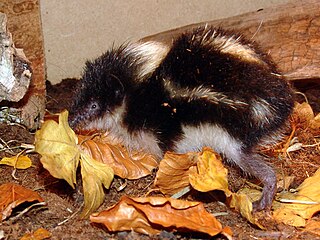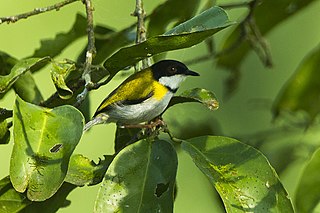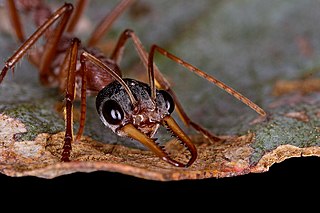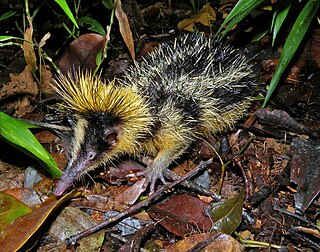Related Research Articles

The great Indian bustard or Indian bustard, is a bustard found on the Indian subcontinent. A large bird with a horizontal body and long bare legs, giving it an ostrich like appearance, this bird is among the heaviest of the flying birds. Once common on the dry plains of the Indian subcontinent, as few as 150 individuals were estimated to survive in 2018 and the species is critically endangered by hunting and loss of its habitat, which consists of large expanses of dry grassland and scrub. These birds are often found associated in the same habitat as blackbuck. It is protected under Wildlife Protection Act 1972 of India.

The black-headed night monkey is a night monkey species from South America. It is found in Brazil, Bolivia and Peru. The A. nigriceps in Peru were notably inhabiting areas that were degraded, and often these areas were disturbed either by human activities or natural occurrences in the ecosystem.

The black-headed marmoset is a marmoset species endemic to Brazil. It inhabits humid tropical rainforest, mostly second growth and edge; the distribution is not exactly known but is thought to be Rio dos Marmelos in the north and east, Madeira River in the west and Ji-Paraná River in the south.

The highland streaked tenrec is an insectivore which lives in the central upland regions of Madagascar. Its black and white striped body is covered with quills, which it will raise when agitated. The spines detach and remain in the body of an inquisitive predator. The function of the black and white pattern may be to mimic juvenile Tenrec ecaudatus since the parents of this species are known to be aggressively protective, and the stripes may have developed as a type of camouflage while foraging. The highland streaked tenrec uses its long snout to burrow under leaves and bark, searching for earthworms, its primary food.

The black-crowned sparrow-lark is a species of lark in the family Alaudidae. It is found across northern Africa from Mauritania through the Middle East to north-western India. Its natural habitat is dry savanna.

The mountain greenbul, or eastern mountain greenbul, is a species of the bulbul family of passerine birds. It is found in eastern Africa.

The black-capped apalis is a species of bird in the family Cisticolidae. It is sparsely distributed throughout the tropical rainforest of Sub-Saharan Africa.

Myrmecia nigriceps, also known as the black-headed bull ant, is a species of ant endemic to Australia. A member of the genus Myrmecia in the subfamily Myrmeciinae, it was first described by Austrian entomologist Gustav Mayr in 1862. These ants are large, varying from 19 to 23 millimetres in length. However, colonies contain workers that are much smaller, usually half the size of normal workers. The queens are the largest while the males are the smallest, which can be easily identified due to their small mandibles.

Hemicentetes is a genus of tenrec with two species, present on the island of Madagascar, species in this genus are called streaked tenrecs.

Nemophas is a genus of longhorn beetles of the subfamily Lamiinae, containing the following species:

The black-headed sugar ant, also known as the brown sugar ant, is a species of Formicinae ant endemic to Australia. Found throughout most states, the species is a member of the genus Camponotus, a cosmopolitan genus of ants commonly known as carpenter ants. It was formally described and named by British entomologist Frederick Smith in 1858. These ants are characterised by their black head, reddish-brown mesosoma and black gaster, which can change in colour.
Nemophas grayii is a species of beetle in the family Cerambycidae. It was described by Francis Polkinghorne Pascoe in 1859, originally under the genus Monohammus. It is known from Moluccas.

Nemophas incensus is a species of beetle in the family Cerambycidae. It was described by Francis Polkinghorne Pascoe in 1866. It is known from Moluccas.
Nemophas leuciscus is a species of beetle in the family Cerambycidae. It was described by Francis Polkinghorne Pascoe in 1866. It is known from Moluccas.

Nemophas ramosi is a species of beetle in the family Cerambycidae. It was described by Schultze in 1920, originally as a subspecies of Nemophas rosenbergii. It is known from the Philippines.

Nemophas subterrubens is a species of beetle in the family Cerambycidae. It was described by Heller in 1924. It is known from the Philippines.
Nemophas tomentosus is a species of beetle in the family Cerambycidae. It was described by Buquet in 1859, originally under the genus Apriona. It is known from the Solomon Islands and Papua New Guinea.
Nemophas trifasciatus is a species of beetle in the family Cerambycidae. It was described by Heller in 1919. It is known from Moluccas.
Nemophas zonatus is a species of beetle in the family Cerambycidae. It was described by Lansberge in 1880. It is known from Indonesia.

The black-capped paradise kingfisher or black-headed paradise kingfisher, is a bird in the tree kingfisher subfamily, Halcyoninae. It is native to several islands in the Bismarck Archipelago to the east of New Guinea. Like all paradise kingfishers, this bird has colourful plumage with a red bill and long distinctive tail streamers.
References
- ↑ BioLib.cz - Nemophas nigriceps. Retrieved on 8 September 2014.